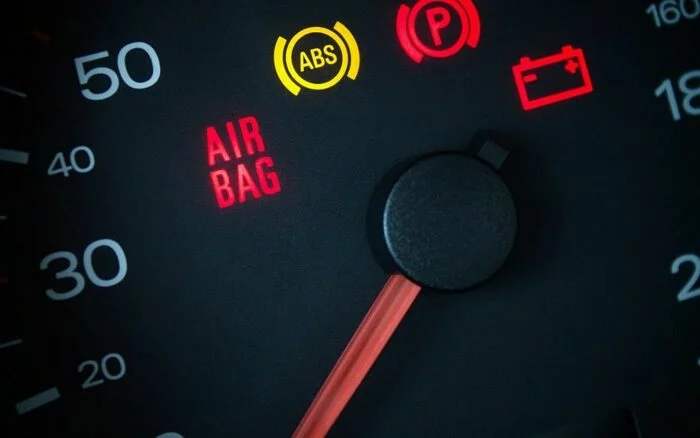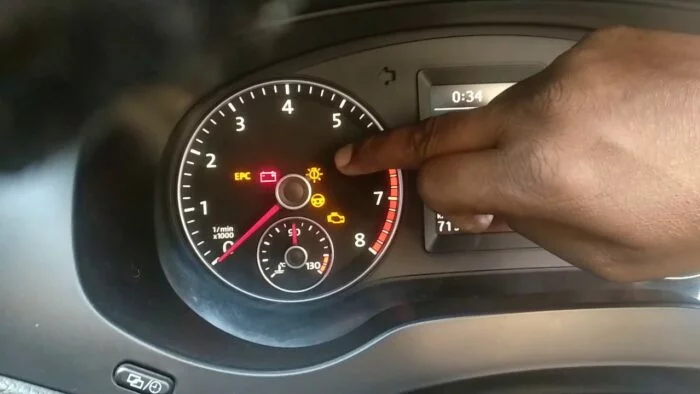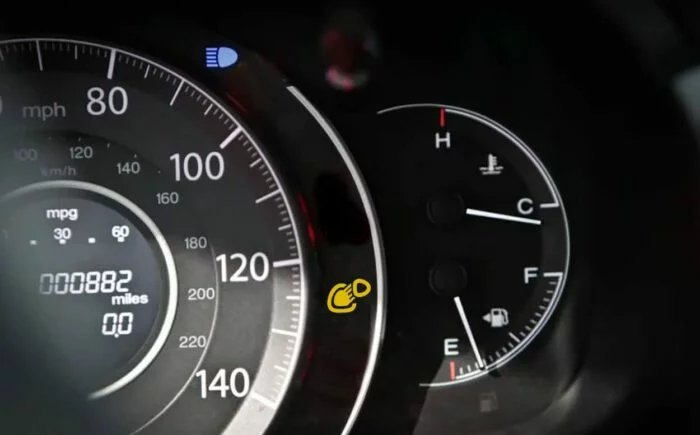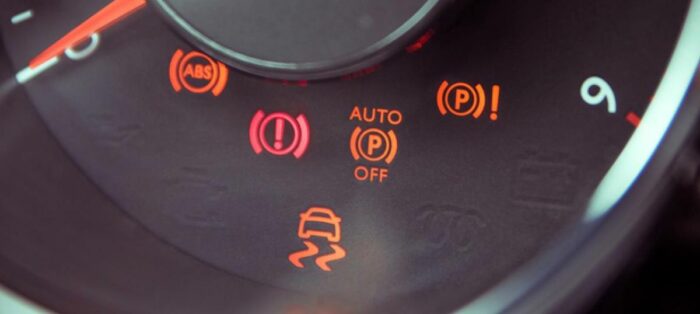Every driver has been there at one point or another when suddenly, without warning, a little car warning light flickers on the dashboard. It’s that moment of confusion and mixed concern.
Knowing what each dashboard warning light means can help you better understand your vehicle and make informed decisions about repairs or routine maintenance.
Failure to pay attention to these dashboard lights can result in costly damages or unsafe circumstances. Let’s find out what the red, amber, and green lights on the dashboard mean.
What Do Dashboard Light Colors Mean?
The color of a dashboard light will give you an idea about the condition of your car. Generally, the colors used for dashboard lights are red, yellow or orange, and blue or green.
- Red Lights: These are usually for critical trouble. A red light means ‘stop immediately.’ For example, the engine temperature light would mean your engine is too hot and should be shut off immediately since running it will create severe damage.
- Yellow or Orange Lights: These lights indicate caution and usually mean something needs attention soon. They do not require an immediate stop but also must not be neglected. For instance, a check engine light may mean something minor is going on, but it could mean something serious.
- Blue or Green Lights: These are information lights, indicating something is operating just right. Take the high beam light, for instance, which warns you that high beams are turned on and nothing goes out of order.
Knowing these colors is the first step to safe driving. Understanding the difference leads to the right action in a snap.
Red Dashboard Lights Explained
The red dashboard lights should immediately catch your attention, as they indicate serious problems involving your safety or your car’s functionality. Let’s have a closer look at these critical warning lights:
Engine Temperature Warning Light

When this light comes on, you should immediately exit the road onto the shoulder area of the highway and shut off the engine to let it cool down. Overheating can cause heavy damage to engine parts. This light typically resembles a thermometer in water.
Possible Reasons for the Engine Temperature Warning Light
Your coolant might be low, and insufficient coolant is present to maintain a cool level in your engine. This may be because your cooling system has sprung a leak.
Other occasions may include a sticking thermostat or malfunctioning water pump causing overheating. If you continue driving without acknowledging this light, a blown head gasket or an entire engine failure may occur.
Oil Pressure Warning Light

This is a symptom of your engine’s lack of sufficient oil. If low oil pressure remains unchecked for a lengthy period, severe engine damage may occur. This light normally takes an oil-can shape; when it is on, the engine is not lubricated as it should be.
What Could Cause an Oil Pressure Warning Light
This could be due to low oil levels, such as a leak or a failing oil pump. Old or dirty oil can also contribute to these pressure problems. This is one light that you don’t want to continue driving around with, as it can cause serious wear or complete failure of the engine.
Active Parking Brake Light

This light indicates that your parking brake is on. Although it may seem harmless, driving with the parking brake on will damage your vehicle’s braking system. This light often looks like an exclamation point inside a circle with the letter “P.”
Possible Causes for Active Parking Brake Light
You may have forgotten to release the parking brake. Sometimes, the brake could be bad and require immediate attention.
ABS Warning Light

This is an indication that your Anti-lock Braking System is having an issue. You can still apply the brakes as normal. However, if this light is on, your ABS will fail to work as needed. The ABS systems help the wheel lock up during heavy braking.
Probable Causes of the ABS Warning Light
You might have a bad wheel speed sensor or a problem with the module itself. Low brake fluid levels will also light this up, so it’s a good idea to check your fluid first.
Low Brake Fluid Indicator Light

Low brake fluid is an unusually serious topic for the content. This light means something within the brake system is off. If you see this light, you must immediately check your brake fluid level.
Low-Level Brake Fluid Indicator Light Causes
You might have one of two leaks in the brake lines or inside the brake master cylinder. As you use up your brake pads, the brake calipers get further extended out, which can cause low fluid levels.
Brake Pad Warning Light

This light indicates that your brake pads have worn out and that it is time to replace them. It is highly recommended that you never drive with this light on, as driving on old pads can ruin your rotors and lead to costly repairs.
Master Warning Light

The master warning light, usually shaped like an exclamation point inside a triangle, could indicate that your car is having problems.
Possible Reasons for the Master Warning Light
This means something is seriously wrong with one of the systems, and your owner’s manual should be consulted for details. It can be serious, and you should no longer drive without taking action.
Seat Belt Indicator Light

This is a light telling you to put on your seatbelt. It is a basic yet essential signal for your safety. If you are driving and this light comes on, it simply means that one of the passengers in your vehicle has not put on their seatbelt.
Airbag Indicator Light

If this light is on, then your airbag system has a problem. If the airbag light stays illuminated, it indicates that your airbags may not deploy in a crash.
Open Hood Light

This light is on when your hood is not properly closed. It reminds you to make sure everything is secure before driving.
Open Trunk Light

This light lets you know that your trunk is open while driving, which is practical to avoid accidents or losses.
Open Doors Light

If the light is on, one or more doors are open. Before driving, it is desirable to check that all the doors are closed tightly.
Battery or Charging System Warning Light

This light indicates that something could be wrong with your battery or your alternator. If it illuminates, it may mean that your car will not start much longer.
Possible Causes of the Battery or Charging System Warning Light
You could have a weak or dying battery or a failing alternator. Sometimes, this light can be set off by a loose or corroded connection, so be sure to check your battery terminals for problems.
Power Steering Problems Light

This light will notify you of an issue with your power steering system. If it lights up, your steering may become heavy, making it difficult to maneuver your vehicle.
Common Causes for Power Steering Problems Light On
You might be low on power steering fluid level or have an issue with your pump. The inability to check this may cause a complete loss in your power steering.
Low Key Battery Light

If this light turns on, it is time to replace your key fob battery. A dead key battery will not enable you to start your car.
Towing Hitch Warning Light

This is an indication that something is wrong with your towing setup. If you want to tow a trailer, ensure this light is off before proceeding.
Some of the possible causes of the Towing Hitch Warning Light
- A faulty connection
- An overloaded hitch
Adjustable Suspension Problems Light

This light represents issues related to your vehicle’s adjustable suspension system.
Possible Causes for the Adjustable Suspension Problems Light On
You may have a failed air compressor or leaking air springs. A suspension system failure will jeopardize the quality of your ride and your safety.
Yellow or Orange Dashboard Lights Explained
Yellow or orange-colored lights represent caution and usually signify that maintenance is required or a condition needs to be checked. They do not always require an immediate stop, but you should not ignore them. These include:
Check Engine Light

This is one of the most common warning lights and can mean many different things. It can mean an easy-to-fix problem, such as a loose gas cap, or something serious is happening, such as a failing catalytic converter. This light comes in different forms but usually appears as an engine silhouette.
Potential Reasons for the Check Engine Light
A loose or faulty gas cap is a common problem. However, it can also indicate problems with the ignition system, mass airflow sensor, or exhaust system. To diagnose the issue, use an OBD-II scanner.
RELATED: Can I Drive my Mercedes with a “Check Engine” Light On?
Traction Control Light

This is a sign that traction control is on. It will come on during slippery driving or when your vehicle briefly loses grip around a sharp curve.
What Causes the Traction Light to Come On
It turns on when driving in rain or snow, so the system operates well to avoid wheel spin. If the light does not go away, it means that there is some defect in the traction control system, and investigation might be required.
RELATED: 7 Reasons Why ABS and Traction Control Lights Are On
Tire Pressure Warning Light

This light indicates that one or more tires are underinflated. Good tire pressure is also important for the required safety and fuel efficiency while driving.
If this light is on, you should have your tire pressures checked as soon as possible. Traveling on low-pressure tires will result in blowouts and uneven wear.
Service Vehicle Light

This warning indicates that your vehicle needs regular maintenance. It reminds you to service your car so that it keeps running well.
It could be a call for an oil change or several other regular tune-ups. Ignoring this type of light might lead to more significant problems later on.
Replace Lamp Light

This light means that a bulb has burned out. Clearly, these need to be changed as soon as possible for your safety.
Adaptive Light System Light

This light means there is a problem with your vehicle’s adaptive lighting.
Possible Reasons for the Adaptive Light System Light
You have an issue with a sensor or a wiring problem. If this light remains on, you will want to have it checked so that your headlights can function properly.
Rear Fog Lights Indicator

This light illuminates when your rear fog lights are on. Although rear fog lights can improve visibility in foggy weather, it’s best to switch them off in clear weather.
Windscreen Defrost Light

The light shows that your front windscreen is defrosting. It is important to provide clear vision in cold weather.
Rear Window Defrost Light

This light means your rear window defroster is working. It helps to wipe the frost or fog from the back of your rear window.
Key Not in the Vehicle Light

This light means the on-board computer does not detect the key fob inside. If this light comes on, first check that your key fob is in the car before turning the engine on.
Glow Plug Indicator Light

This light illuminates in diesel cars to indicate that the glow plugs are heating up. It is crucial to wait until this light goes out before firing the engine.
Low-Temperature Warning Light

This light tells you that your engine is running too cold, which may affect performance.
Press Clutch Pedal Light

This light indicates that you forgot to press the clutch pedal ( in a manual transmission) before starting the engine.
Particulate Filter Problems Light

This means there is something wrong with your vehicle’s particulate filter.
Possible Causes of Particulate Filter Problems Light
There may be a blockage in the filter where you can feel a fall in the performance and efficiency of the engine.
Catalytic Converter Problems Light

This is the light for an issue with the catalytic converter.
Possible Causes for the Catalytic Converter Problems Light
You may have an exhaust leak or the converter is failing. Failure to heed this light may result in an expensive repair.
Headlights Control Problems Light

This light indicates you have some issues with your headlights, and your visibility will be poor.
Rain Sensor Problems Light

This light comes on when your rain-sensing wipers are malfunctioning. If it is on, you should check your wiper system for faults.
Low Windshield Fluid Light

This is an indicator that your windshield washer fluid level is low.
Traction Control Off Light

This is an indication that the traction control system is off.
Automatic Gearbox Warning Light

This light comes on if something is wrong with your automatic transmission.
Possible Causes for the Automatic Gearbox Warning Light
You could have low transmission fluid or a sensor problem that may cause poor shifting.
Blue or Green Dashboard Lights Explained
Blue or green lights are more often called information lights. They let you know that something is operating properly.
Low Engine Coolant Temperature Light

This lets you know the engine is cold, often at start-up.
High Beam Headlights Light

This light illuminates to let you know your high beams are on. This is helpful at night; however, you should always turn off your high beams when meeting oncoming traffic.
Low Beam Headlights Light

This light lets you know that your low beams are activated; this is helpful in regular driving conditions.
Hold Brake Pedal Light

This light reminds drivers to hold the brake pedal while starting the engine in some cars.
Active Cruise Control Lights

These lights indicate that your cruise control system is activated. This setting allows you to regulate a consistent speed that would get you moving on the highway sans the need to step on the gas pedal.
Active Parking Sensors Light

This light indicates that your parking sensors are activated, which helps you avoid contact with objects while parking.
Start-Stop System Light

This light will inform you that the start-stop system is turned on. This system is active for fuel economy, automatically shutting off the engine when it is in idle mode, such as at stop lights.
Final Thoughts
When buying a used car, look closer at the warning lights during the physical inspection and check the car history report for hidden records or defects. The dashboard warning lights will help you detect hidden issues you would not want to handle later. If the warning lights are on, query the seller about them. Use the VIN check service to get as much information as possible to help you decide whether or not the car has ever been involved in an accident, whether it has maintenance issues, or if there are any open safety recalls.
Frequently Asked Questions
A warning light simply means that your car needs attention. It helps you catch issues early before they become serious.
Red lights typically indicate the most serious issues. They could denote things that need urgent attention, like overheating or low oil pressure. These issues are supposed to be addressed immediately before further damage or an accident occurs.
It depends on the light. If it’s red, pull over and check it as soon as you can. There is not much to be worried about for yellow lights, but you should plan to check them out soon.
No, driving through a red warning light can cause serious and major damage; you need to stop the vehicle at the very first safe opportunity. These kinds of warnings are hazardous and expensive to ignore.










